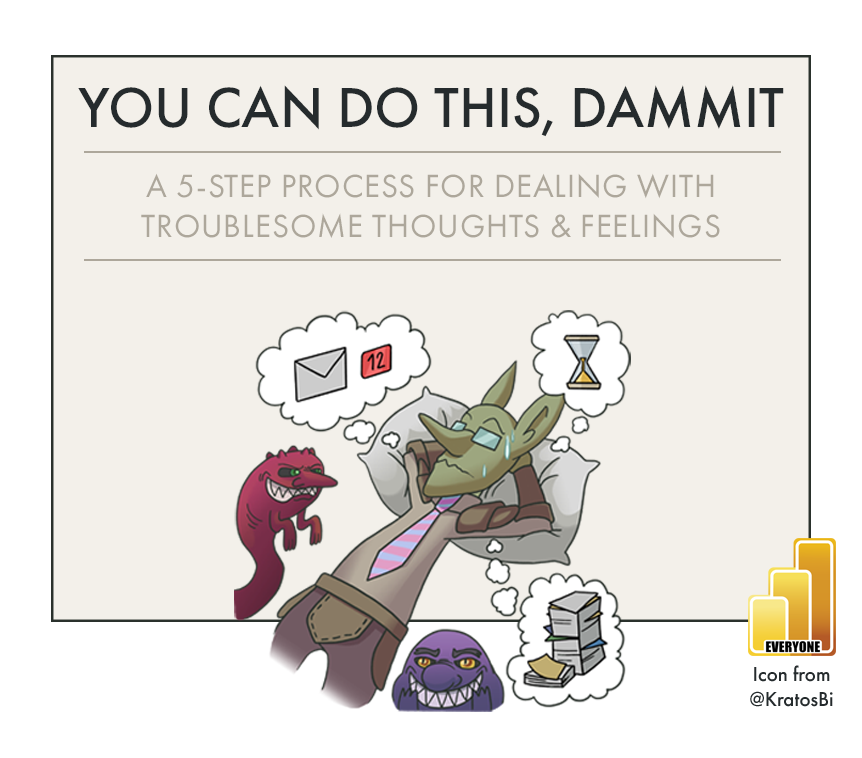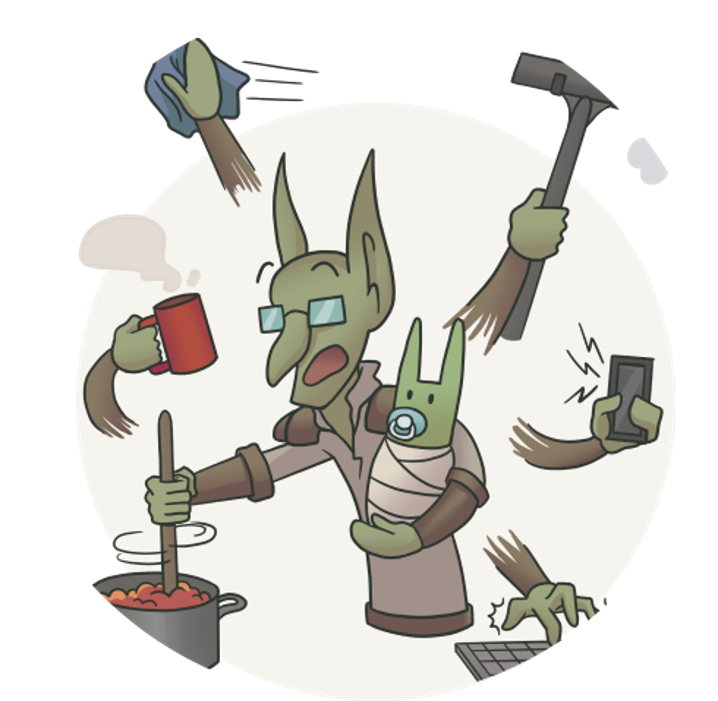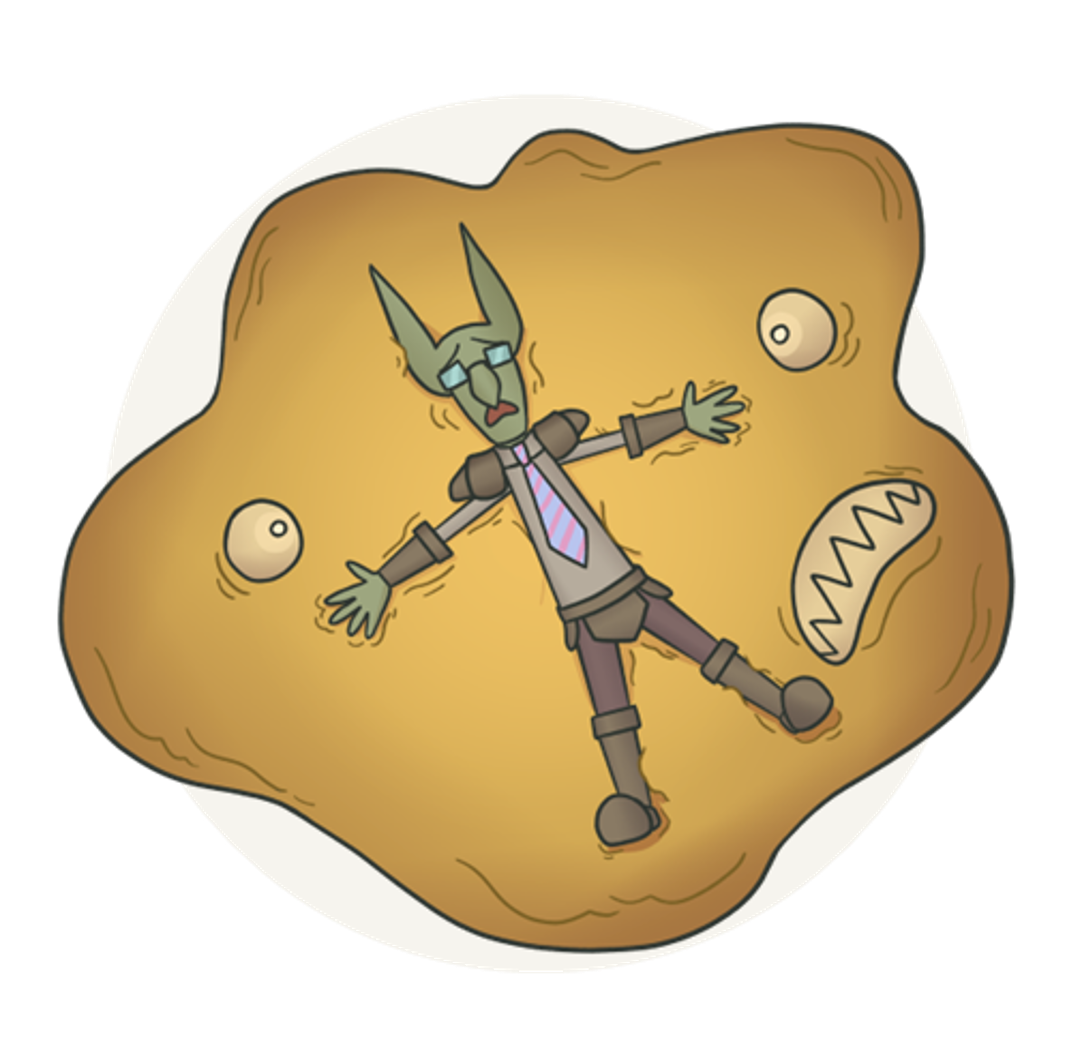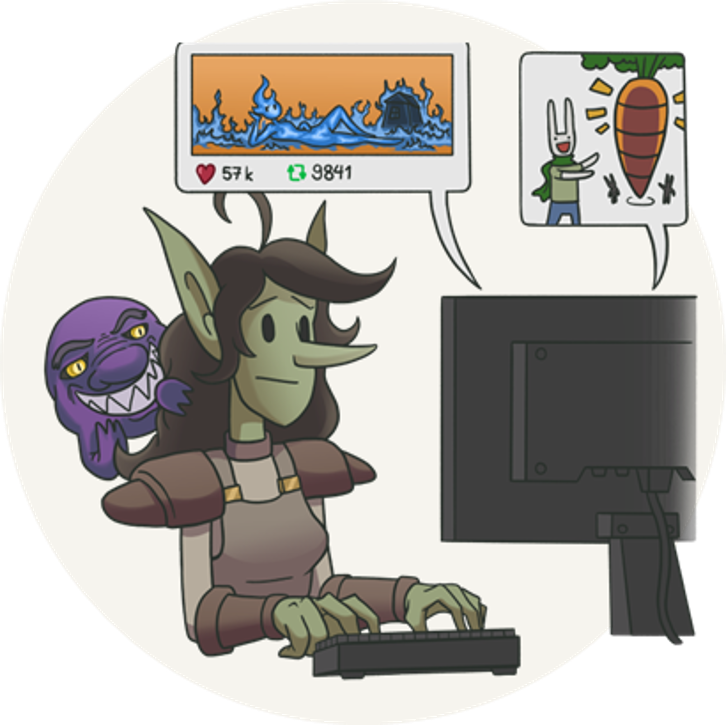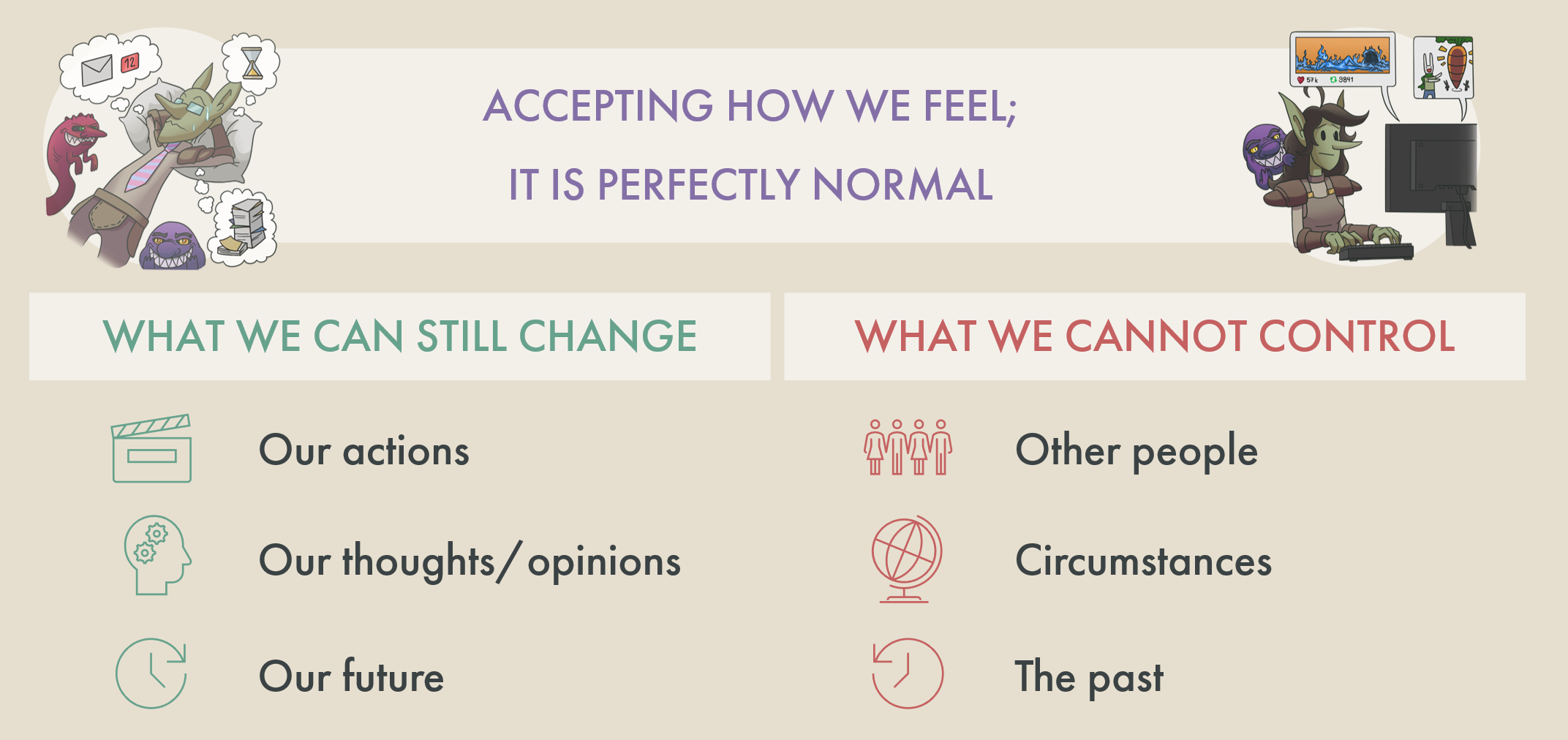You can do this, dammit
IMPROVE MENTAL WELLBEING WITH MINDFULNESS
…by accepting what we can’t control & committing to change what we can.
WHY WRITE ABOUT THIS?
Even in normal times, it can be difficult to manage everything going on in our lives. Juggling family, work, our health and social lives… it’s hard. The last few years have been even harder, and I don’t think we need to discuss why. There seem to be more people struggling with stress & burnout than ever before [1]. Unfortunately, mental health is a difficult topic to discuss. Often, discussion circles around vague concepts and awareness without concretely addressing what we can do. So what can we do when we struggle with negative or disruptive thoughts?
These thoughts and worries are like ‘Gremlins’ that disrupt professional growth and pick away at our mental health. In this post, I aim to share some practical tips on how to deal with them. Specifically, we look at mindfulness as an effective tool to fight back. This means to recognize unpleasant thoughts & worries, accept what we cannot control, and commit to what we can (and want to) change [2, A]. Tools like journaling help make this possible. For example, Learning Journals, where you write daily what you have learned and review it at the end of your workday. While not a one-size-fits-all approach nor a replacement for professional advice, the hope is to help someone out there — you can do this, dammit!
DISRUPTIVE OR UNHELPFUL THOUGHTS: OUR GREMLINS
Our gremlins follow us around and can harm productivity, health & happiness.
Like bothersome little Gremlins that follow us around, we sometimes have negative thoughts that drag us down. Doubts, worries, memories and feelings that can be both unpleasant and disruptive. They bring feelings of discomfort; a tightness in the chest, or an icy hand around the stomach. They make it hard to focus, steal our motivation and prevent us from reaching our goals. These Gremlins aren’t only hurting our professional growth, but also our mental health. Ultimately, this can lead to disruption of daily function, give us anxiety and stress, harm our productivity, health, and happiness. These Gremlins are not always around, but we’ve all dealt with them at one time or another in our careers.
Scroll down to see examples of these “Gremlins” - disruptive thoughts you may have experienced before:
““Everyone here knows more than me... I don’t belong here...”
”I don’t know what I’m doing.””
““I feel like I’m faking it and it’s only a matter of time before everyone finds out.”
”I’m just pretending; it seems like everyone else knows what’s going on.””
““I’m not doing enough; I should be doing more. I’m not working as hard as everyone else.”
”I feel like an imposter; one day, everyone will find out I’m a fraud.””
““I’m so bad at this... I never do anything right. I’m such a failure.”
”I really need to work on this, but I’m just not motivated... it’s stressful to think about””
““I’m falling behind... I won’t ever catch up to everyone else.”
”I can’t stop thinking about work on the weekend and my holidays...””
““Nothing I do is good enough...”
”I’m so overwhelmed, I wish the world would just pause for a few weeks...””
These intrusive thoughts are examples of little gremlins that bother us. Little anxieties, stress, imposter syndrome… it might seem like you’re the only one, but you’re certainly not alone.
STEP 1: RECOGNIZING OUR THOUGHTS/FEELINGS & THEIR IMPACT
BEING AWARE OF OUR GREMLINS
It’s hard to know when our Gremlins are about
What can we do when we experience these intrusive, negative thoughts? The first step is recognizing instead of avoiding them and their impact on us. It may sound silly, but it can be surprisingly difficult to do. We are so busy, so focused on our daily lives, that we can go on for a long while without recognizing that we might be struggling. By taking the time to pause and examine our thoughts & worries, we can see them for what they are - a collection of words, images and feelings which evoke an unwanted response.
Like a detective sleuthing out a suspect, we can look for clues in ourselves to see if our gremlins are about. Taking this time to give attention to our thoughts is the underlying principle of mindfulness, a helpful tool in improving our mental wellbeing [3].
WHAT DOES IT MEAN TO BE ‘MINDFUL’?
Mindfulness involves practicing activities that draw our attention to the present moment. Traditionally, mindfulness might make you think of yoga or meditation. Indeed, those are examples of mindful activities. However, there are many ways to practice mindfulness. Mindfulness can be done alone, or practiced, from a therapeutic to a more casual or personal setting. Examples might be as simple as taking a break and stretching for 15 minutes, or going for a walk without distractions. These moments are meant for self-reflection and attentiveness to how we are feeling and what we are thinking. This not only helps us relax, but studies also show that consistently practicing mindfulness results in reduced stress and improved overall wellbeing. Mindfulness isn’t just a trend, but a real tool to combat our Gremlins and achieve a healthier, happier life. [3, 4, 5].
EXAMPLES
-
The Situation
Bonk has been feeling stressed and overwhelmed about work, ever since he started a big Power BI project. He finds he can’t stop thinking about work on the evenings or weekends, making it hard for him to enjoy his spare time. He’s been avoiding checking his mails and project tools because it adds to his stress, but then he feels guilty for procrastinating. It’s getting to the point where his chest is always tight - the night before work he struggles to do anything because he’s anxious or stressed about the next workday. In general, he feels this is making it hard for him to focus and be motivated.
Step 1: Acknowledgement
Bonk decides to practice some mindfulness and give his thoughts some attention. He decides to go for a 20-minute walk in the morning and afternoon, where he pays attention to what he’s thinking and feeling. He notices thoughts putting himself down, doubting his abilities - things similar to the below:
“I really need to top procrastinating, I’m so lazy.”
“I’m not going to make this deadline. The project will fail because of me.”
“I’m as good as my team; I’m slowing them down. They’d be better off without me.”
“I can’t do this. I should call in sick. I should quit.”
Bonk notes down these thoughts and lets them come and go. After a week or so, he starts to notice them during his work-day. “Oh, I’m having those thoughts, again.”
-
The Situation
Bink is a developer interested in growing her career. She’s been trying to get involved in the data community, but it’s giving her stress. When she started attending conferences and participating in online discussions, she felt like everyone knew so much more than her. While Bink was once a bit sure of her abilities, she now was doubting herself. She doesn’t want to speak at any events, because ‘no one will be interested in what I have to say’. Further, she’s starting to feel like she’s constantly falling behind; there’s a constant pressure pushing her. Even in her own company, Bink has been feeling like nothing she makes is any good.
Step 1: Acknowledgement
Bink decides to join a group yoga class offered a few days a week at lunch, nearby. She also decides to spend some time in the evening painting, something she used to enjoy a lot. During these times, she tries to be mindful of what she’s thinking and feeling. She notices a lot of “imposter” thinking, and self-doubt:
“Everyone is knows so much more than me. I’m falling behind.”
“Nothing I made is as good as this.”
“I need to do more; I’m not doing enough.”
“If everyone knew my skill level they’d realize I’m a fake.”
“I don’t belong here.”
Bink starts to notice these “imposter thoughts” coming up whenever she sees impressive work from others, or participates in discussions with other experts.
STEP 2: ACCEPTING WHAT WE CANNOT CHANGE/CONTROL
ACCEPTING THAT IT’S OK TO FEEL THE WAY WE DO
Once we are aware of our thoughts and worries, we come to an important step. We should acknowledge that it’s okay to feel this way. It’s normal. It’s human. That huge reporting project that’s disrupting your sleep and giving you knots in your stomach? Normal. That big data warehouse migration you’re worried won’t be delivered on time? Perfectly normal to worry. It’s okay to feel the way we do, and one of the first steps in feeling better is to accept that.
““Unfortunately, all too often when we try to avoid or get rid of unwanted private experiences, we simply create extra suffering for ourselves.””
So often with these thoughts and worries, we have the reflex to fight back; to make them go away. To avoid them. It’s hard for us to just tell ourselves — this is normal. This is okay. It’s okay to not be okay. Too often we deny ourselves the permission to feel the way we do because “it’s not as bad as [something else]”. Another person’s suffering or difficulties does not invalidate our own. We all have the right to struggle; we all have the right to feel the way we do.
WHAT WE CAN AND CANNOT CHANGE
We must identify and accept what we cannot control or change. By accepting some things, we remind ourselves that it’s not helpful to distress about it. Instead, we can focus on the actionable points; the things we can and want to change, and commit to changing them [2, A].
ACCEPTANCE IS HARD
OK - so we should accept what we cannot change. But of course, It’s easier said than done. It’s important to remind ourselves that accepting our feelings is a process that takes time and effort, for example by practicing mindfulness.
EXAMPLES
-
The Situation
Bonk has been feeling stressed and overwhelmed about a large reporting project. It’s been having a negative impact on his productivity and his happiness. Lately, he’s been doing some mindfulness activities and noticed a lot of unhelpful thoughts weighing him down.
Step 2: Acceptance
During his mindfulness activities, Bonk started having a mental dialogue with himself, identifying things he could change, and things he cannot control.
One of the things giving Bonk a lot of distress was his guilt over procrastinating in the past. This is not something Bonk can change; he can’t change the past. Instead, he can look to the future and focus on changing his behavior, reducing procrastination moving forward if he understands when and why he is doing it.
Bonk is distressed about parts of the project that aren’t going well. Things like missing or bad quality data that he knows will cause delays. Further, the project team has not been preparing any training or adoption actions, and he knows this will hurt end-user adoption of the solution. This isn’t something he can control; he can try to raise these points, or help if he has time, but he can’t control it from his role in the project.
-
The Situation
Bink has been trying to get more involved in the data community, and also work with other data teams in her company. She’s been noticing that she’s experiencing a lot of self-doubt, feeling like she’s not as skilled or knowledgeable as her colleagues.
Step 2: Acceptance
Bink finds it difficult to mentally reflect on these points, so she starts keeping a journal. She reminds herself that her feelings - imposter syndrome - is very common and normal. She also accepts that she can’t control what other people do or share, and that it is impossible to keep up with everything.
STEP 3: WHY DO WE FEEL THE WAY WE DO?
SEEING OUR GREMLINS FOR WHAT THEY ARE
We’ve now seen our Gremlins and accepted that they are there, and there are parts of them that we can’t control. The next step is understanding them, so we can take the right, helpful actions to feel better. Understanding our thoughts and feelings is simply about connecting them to our behaviors and values. Why might we feel the way that we do? This might sound vague, but it’s quite easy:
EXAMPLES
Situation 1: Starting at a new employer, you’re wracked with anxiety & stress.
Step 1: You find you’re often thinking “I’m not ready” or “I might be in over my head”; doubting yourself.
Step 2: You accept this is normal, and also won’t change that you’re going to start at this employer.
Step 3: It’s normal because you’re going to an unfamiliar environment and want to do a good job;
You feel you’re anxious and doubting yourself because you value your work - you want to succeed.
Situation 2: Working on a big project with a distant deadline, you’re procrastinating & feel guilty about it.
Step 1: You sometimes think “I’m being lazy” or “I don’t want to deal with this, yet”; you’re overwhelmed.
Step 2: You accept this is normal. Everyone procrastinates. You shouldn’t feel guilty about your past procrastination because that’s not helpful; you can’t change the past.
Step 3: You think you procrastinate because starting the work means confronting yourself with how much there is to do. It’s overwhelming to see what lays ahead. By procrastinating, you avoid this feeling to deal with it later. But then you feel guilty for not starting it, because you value your work ethic.
Analyzing our feelings is sometimes explained as using rational facts to combat irrational emotions. Here, it is more about simply understanding why we feel the way we do, connecting it to our values [2, A].
STEP 4: FIGHTING BACK - TAKING HELPFUL ACTIONS
ACTING TO ACCEPT OR CHANGE
“If these thoughts are unhelpful, then what would be helpful? What can we do that would help, here?” When confronted with these thoughts & feelings, we can do two things:
Accept what we can’t control:
Acceptance is a key part to feeling better, but it’s challenging. Working to accept things means consistently repeating these mindfulness activities, and working toward acceptance.Commit to changing what we can and want to change:
Change - like acceptance - is not easy. It involves setting realistic, incremental goals and working toward them while tracking progress. There are many ways to do this, but the one discussed below involves Habit Journaling.
Actions can take many shapes and forms. What’s common between them, though is that to be done successfully, they require consistency to have a long-term effect and the discipline to keep doing it, even when short-term benefits aren’t immediately apparent. This is best illustrated with an example, one of the more common ways to work toward both acceptance and change, journaling.
JOURNALING - A SIMPLE WAY TO COMBAT YOUR GREMLINS
A common - and increasingly popular - method to improve mental health is journaling. Journaling is a mindfulness activity, which involves keeping a private, daily log for particular thoughts, behaviors or events. Journals can take various types and formats, from physical pen & paper to digital - there are dozens of mobile apps designed for this purpose. While this might sound like a wellness trend, journaling is backed by scientific research to improve mental wellbeing and overall satisfaction after journaling daily for longer periods of time [6-10]. Below are three examples of journaling that can be helpful:
1. LEARNING JOURNALS:
If you feel like you aren’t learning enough, or aren’t getting much satisfaction from your work, a learning journal can be a nice way to make clear what you learn in a day. The simple idea is that you keep a new, dated page at your desk, and write down each new thing you’ve learned that day, as you learn it. At the end of the day, you have a list of everything new you learned. It’s quantifiable proof that you accomplished something that day — keeping you mindful of your otherwise intangible progress.
2. GRATITUDE JOURNALS:
Gratitude journals are a powerful way to bolster your mental health, and has shown to have real benefits to improve wellbeing [6-10]. Best explained by the YouTube channel Kurzgezagt, gratitude is an important trait that was essential in humans to create healthy social bonds & community, where we reciprocate acts of generosity. In a gratitude journal, you record daily what you are grateful for in your day & life. This mindfulness activity serves as a powerful reminder of the positive things in our lives; a hefty counterbalance to the Gremlins that like to stand on the negative side of the scale. For more information, check out their YouTube video on the subject.
3. HABIT JOURNALS:
Some of the hardest things to change are behaviors that have become nearly automatic. Habits - like brushing our teeth, checking social media, or going for a run - take a long time to train. Changing an unhealthy habit to a healthy one is one of the more difficult changes we can make, requiring the ultimate amount of discipline and consistency. Habit journals make this easier by providing a simple way for us to track goals and progress, but more importantly to be mindful of them on our journey to change. For more information, check out this Kurzgezagt YouTube video.
Kurzgezagt also sell gratitude journals & habit journals through their online shop. I’ve bought them, they’re pretty great! (No, they’re not sponsoring this post 🙂 ).
STEP 5: PREVENTION
Seek to be a bridge-builder with a focus on empathy - you will help both yourself as well as others
CREATING A HEALTHY, BALANCED ENVIRONMENT
When things are going well and there are no Gremlins about, we can still improve our mental health with preventative action. There are many ways to do this - getting sufficient sleep & exercise, eating healthy, and ensuring we have an active social life. Additionally, we can ensure that the mindfulness activities discussed above persist, even when we are well. By keeping the habit of practicing mindfulness, for example with a gratitude journal, we solidify it as a consistent practice for our own benefit. In this sense, mindfulness is no different than brushing our teeth, or going to sleep on-time.
However, part of this prevention is not just internal, but also external. We should seek to create a healthy, balanced environment not just for ourselves, but also for others. We can do this by not only being mindful of our own feelings, but how our actions and behavior affects others. Putting empathy first helps us see things from others’ point-of-view, and is also essential when creating data solutions that others will use. In doing this, we can ensure that our professional environments are not just healthy, but also sustainable.
TO CONCLUDE
Mental health is important, but it’s difficult to talk about in a concrete way, and find ways to improve it. Damage to our mental health by disruptive or unpleasant thoughts can affect our productivity, happiness and health. However, in using mindful practices we can be aware of and combat these Gremlins, by accepting what we cannot change and committing to changing what we can. Thinking like this can hopefully improve the mental wellbeing of not only ourselves, but also those around us. Life is hard for everyone, but together, we can hopefully make it easier.
You can do this, dammit. I believe in you.
Did you find this interesting? If so, join my presentation at DataMinds Connect 2022 on October 11!
I’ll also give away 10 gratitude journals and 10 habit journals from Kursgesagt; first-come, first-serve!
-
Disclaimer: The above is not professional psychological advise, rather sharing simply what has worked for me. If experiencing a psychological or mental health crisis, please reach out to a doctor or psychological professional in your area.
References & Further Reading:
[10]. Kini et al., 2016. The effects of gratitude expression on neural activity. NeuroImage.
General Sources & Recommended Reading:
Acceptance & Commitment Theory:
[A]. Harris, R. 2008. The happiness trap: How to stop struggling and start living. Trumpeter Books.



